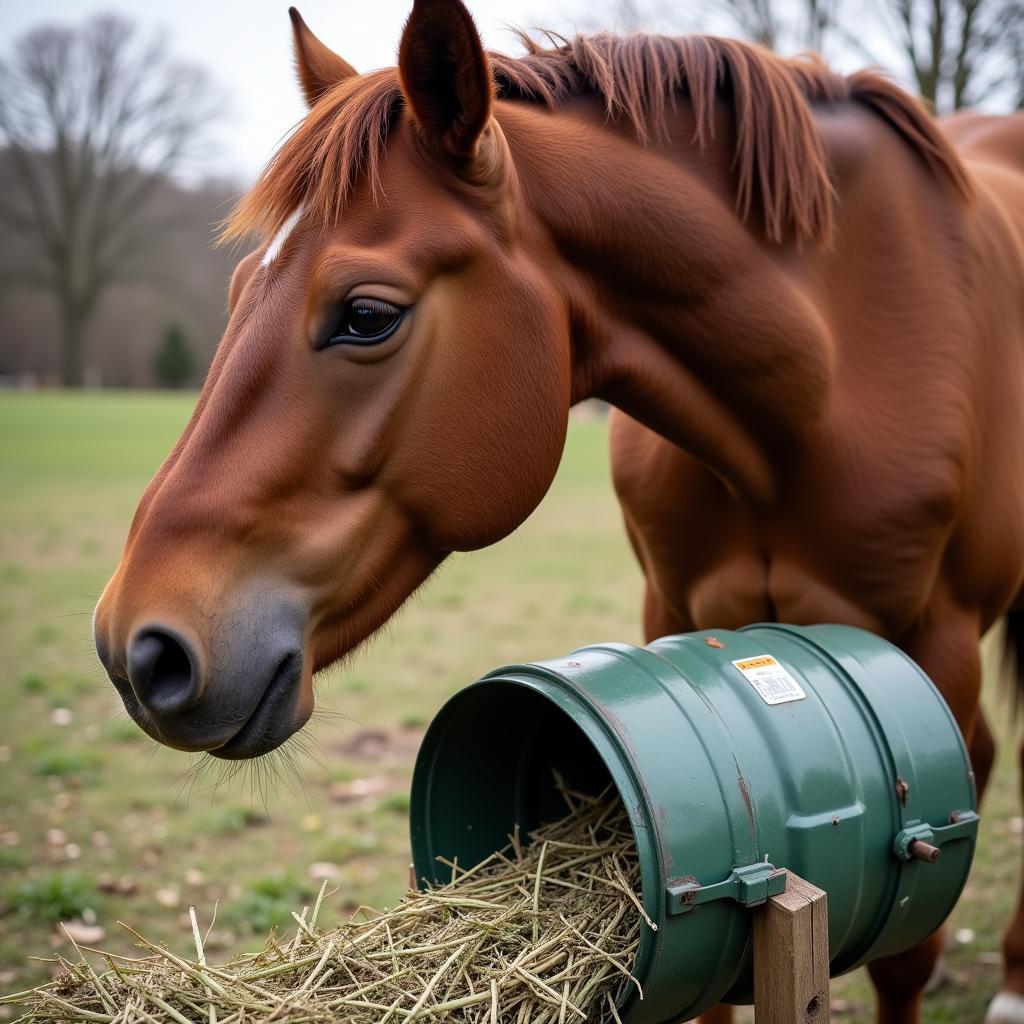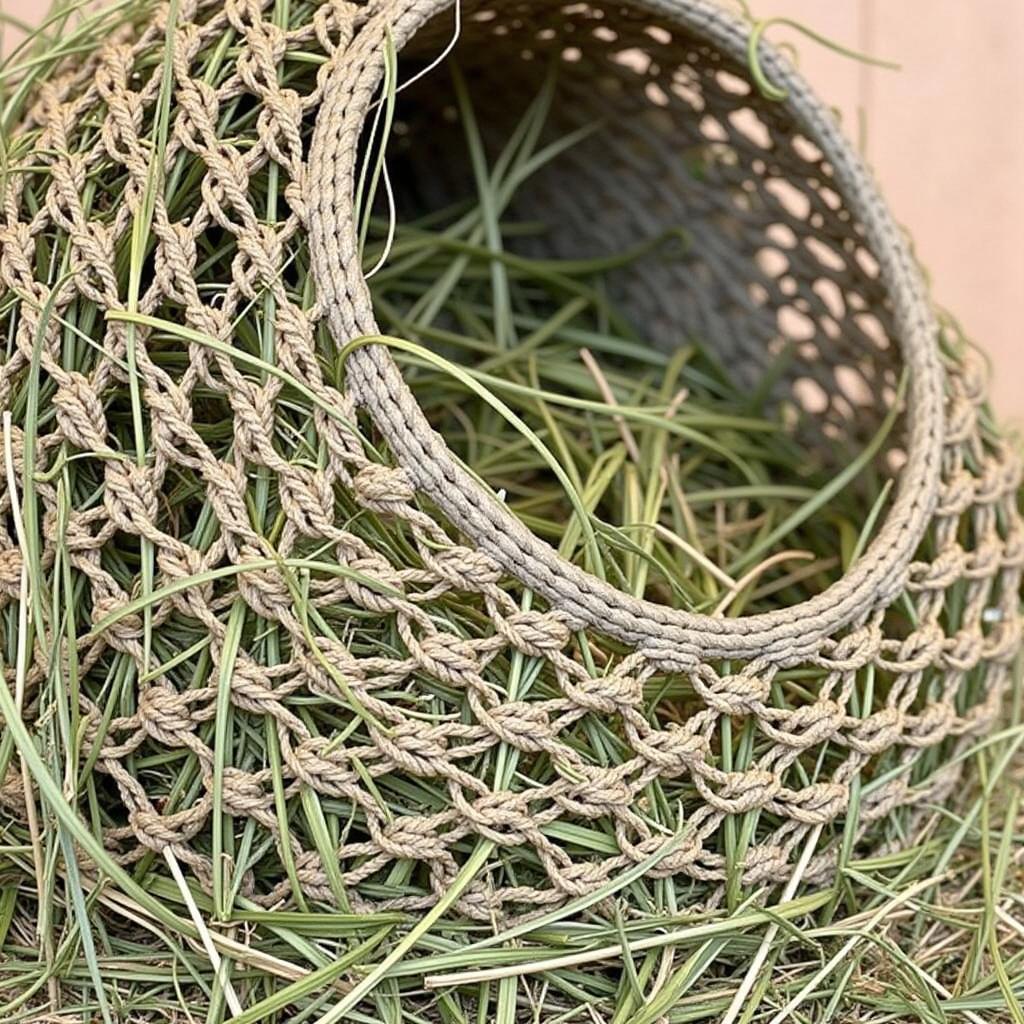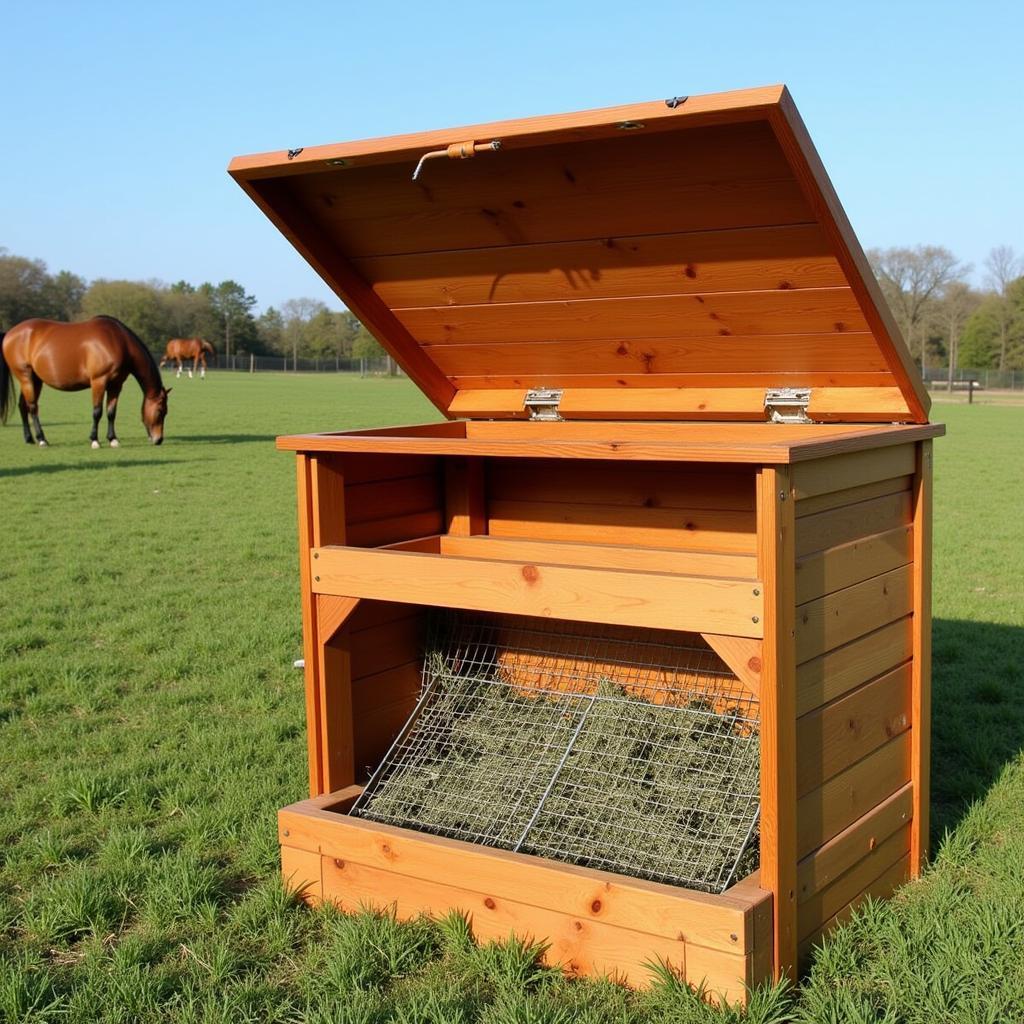Slow feeders have become increasingly popular among horse owners as a way to mimic natural grazing patterns and promote equine digestive health. If you’re handy and enjoy a good DIY project, building your own slow feeder can be a rewarding and cost-effective way to provide your horses with this beneficial feeding method.
Why Use a Slow Feeder for Your Horse?
Horses are designed to graze for up to 16 hours a day, consuming small amounts of forage throughout that time. Modern horsekeeping practices often involve feeding large meals of grain or hay less frequently, which can lead to digestive issues like ulcers and colic. Slow feeders prolong eating time, encouraging your horse to eat more slowly and naturally.
 Horse Enjoying DIY Slow Feeder
Horse Enjoying DIY Slow Feeder
Here are some key benefits of using a slow feeder for your horse:
- Reduced risk of digestive upset: By slowing down consumption, slow feeders help maintain a steady flow of saliva and digestive juices, reducing the risk of colic and ulcers.
- Promotes natural grazing behavior: Slow feeders encourage horses to eat in a more natural head-down position, which is better for their respiratory system and overall well-being.
- Mental stimulation and reduced boredom: The act of foraging for food in a slow feeder provides mental stimulation and can help alleviate boredom, which is especially important for horses that spend long periods in stalls or paddocks.
- Can aid in weight management: By extending feeding time, slow feeders can help prevent overeating and contribute to a healthier weight for your horse.
Types of DIY Slow Feeders for Horses
There are many different types of DIY slow feeders you can build, from simple hay nets to more elaborate feeders made from recycled materials. The best type of slow feeder for your horse will depend on their individual needs, your budget, and your DIY skill level.
1. The Classic Hay Net
Hay nets are one of the simplest and most affordable types of slow feeders. You can purchase a ready-made hay net or easily make your own using strong twine or rope. When choosing or making a hay net, be sure to select one with small enough holes to effectively slow down your horse’s eating.
 Close-up of DIY Hay Net
Close-up of DIY Hay Net
Tip: To prevent your horse from getting their hooves caught, hang hay nets at chest height or higher.
2. The Versatile Bucket Slow Feeder
Plastic buckets or tubs can be easily transformed into effective slow feeders. Simply drill holes around the sides and bottom of the bucket and secure a sturdy rope for hanging.
Tip: For added safety, consider using a rubber bucket or lining a plastic bucket with a rubber mat to protect your horse’s teeth.
3. The Upcycled Tire Slow Feeder
Old tires can be repurposed into durable and long-lasting slow feeders. Securely fasten the tire to a fence post or wall and cut openings large enough for your horse to access the hay.
Tip: To prevent injury, make sure there are no sharp edges or protruding wires on the tire.
4. The DIY Slow Feed Hay Feeder
For horse owners with carpentry skills, building a wooden slow feed hay feeder can be a rewarding project. These feeders typically involve a hay rack with a grate or grid at the bottom to slow down consumption.
Tip: Use pressure-treated lumber to ensure your feeder can withstand the elements.
 Sturdy Wooden Slow Feed Hay Feeder
Sturdy Wooden Slow Feed Hay Feeder
Choosing the Right Slow Feeder for Your Horse
When selecting a DIY slow feeder for your horse, consider these factors:
- Your horse’s size and eating habits: A larger horse will need a larger feeder with more openings than a pony.
- Your budget and DIY skills: Some feeders are more time-consuming and expensive to build than others.
- Safety: Ensure the feeder is free of sharp edges or protrusions that could injure your horse.
- Durability: Choose materials that can withstand the elements and your horse’s wear and tear.
Introducing a Slow Feeder to Your Horse
Once you’ve built your DIY slow feeder, it’s important to introduce it gradually:
- Start slowly: Begin by offering your horse a small amount of hay in the slow feeder alongside their regular hay ration.
- Monitor their behavior: Observe your horse closely to ensure they are adapting well to the new feeder and not becoming frustrated.
- Be patient: It may take some horses a few days or even weeks to adjust to eating from a slow feeder.
“Introducing a slow feeder can be a game-changer for horses prone to digestive issues,” says Dr. Sarah Williams, a veterinarian specializing in equine health. “It’s important to choose a feeder that’s safe, durable, and appropriate for your horse’s individual needs.”
Conclusion
Building a DIY slow feeder for your horse is a great way to improve their digestive health, encourage natural grazing behaviors, and provide mental stimulation. With a little time, effort, and the right materials, you can create a slow feeder that will benefit your equine companion for years to come. For more information on how to keep your horse happy and healthy, check out our articles on [horse toys for boredom] and [slow feeder horse hay].
FAQs
1. How often should I clean my horse’s slow feeder?
It’s important to clean your horse’s slow feeder regularly to prevent mold and bacteria growth. Remove any uneaten hay and wash the feeder with soap and water at least once a week.
2. Can I use a slow feeder for my horse’s grain ration?
While slow feeders are primarily designed for hay, they can also be used for grain rations, especially for horses prone to bolting their food.
3. What if my horse doesn’t take to the slow feeder right away?
Don’t be discouraged if your horse doesn’t immediately adapt to the slow feeder. Be patient and try different strategies, such as introducing it gradually or adding a small amount of their favorite treat to the feeder.
4. Can I leave my horse unattended with a slow feeder?
Always supervise your horse while they are eating from a slow feeder, especially when first introducing them to it, to ensure they do not injure themselves.
5. Where can I find more information on horse care and DIY projects?
For more tips on enriching your horse’s life, browse our selection of [toys for horse lovers].
We understand that you want the best for your equine companion. If you need further assistance with slow feeders or any aspect of horse care, our dedicated team is here to help. Contact us at Phone Number: 0772127271, Email: [email protected] or visit our address: QGM2+WX2, Vị Trung, Vị Thuỷ, Hậu Giang, Việt Nam. We provide 24/7 customer support to address all your queries and concerns.